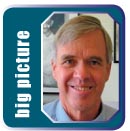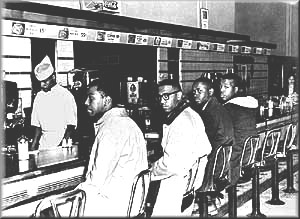 by David Hartsough
by David Hartsough
I had the wonderful opportunity to participate in the 50th reunion of the Student Nonviolent Coordinating Committee (SNCC), April 15-18, 2010, in Raleigh, NC. Over 800 SNCC workers, their families and friends came together for four days to remember, reflect, share stories, inspire a younger generation, and strategize about how to continue the important work that SNCC students started 50 years ago.
Origins of SNCC

SNCC Sit In - Feb. 1, 1960.                                                         Photo courtesy of David Hartsough.
The SNCC reunion attracted many “giants†of the civil rights movement like Jim Lawson, John Lewis, Harry Belafonte, Vincent Harding, Bernard Lafayette, Dick Gregory, Bernice Reagan, Clayborne Carson, Charlie Cobb and Courtland Cox. They joined hundreds of SNCC workers whom most Americans have never heard of, or have long forgotten.
As PeaceWorker readers may remember, the SNCC movement started with four Black students from North Carolina A&T in Greensboro, NC who sat in at a Woolworth drug store on Feb 1, 1960.
This action, by David Richmond, Franklin McCain, Ezell Blair, and Joseph McNeil (pictured below) ignited a wave of student sitins and protests that flashed like fire across the South – a fire for justice that no amount of beatings, jails, or firehoses, could extinguish. Within days, sit-ins occurred in dozens of Southern towns, and in the North supporting picket-lines sprang up at Woolworth and Kress stores from New York to San Francisco.
These students faced the Ku Klux Klan, police dogs, fire hoses, death threats and many spent months in southern prisons. Others were beaten by the police and saw their fellow SNCC workers get shot down and killed . Yet they continued their deep commitment to nonviolence and the struggle for justice and sang “We Shall Overcome†I was reminded how horrendous the oppression was for blacks in the deep South at that time. If a black person in Mississippi or Alabama tried to register to vote, they could be fired from their job, have a cross burned in front of their home, or even have their home or church burned to the ground. Courageous SNCC workers were accompanying these folks as they registered to vote and stood up for their right to live as full citizens in this country.
John Lewis Remembers
To give a flavor of some of what was said at the reunion, here are a few of my notes from a talk by Congressman John Lewis, a former former Chairman of SNCC. “Through peaceful action, we helped transform this country… SNCC was an unbelievable movement to make this a better nation… Hundreds of SNCC workers were willing to take a stand for all humankind… By sitting down, we enabled black people to stand up. We started a nonviolent revolution in this country. ..We had a highly disciplined freedom movement to liberate the soul of America. ..We would not give up. ..We kept our eyes on the prize. ..We were bloodied and beat up, but never gave up. ..SNCC workers gave their lives to make this a more perfect union. ..We cried and kept marching.

“If it were not for SNCC, Barack Obama would not be the President of the US. But the election of Obama was not the fulfillment of our dream, only a down payment. We need to get out and push and organize and make some noise to make the crucial changes still needed for justice in our beloved country.
“We all live in the same house. We are one people, one family, and all live in our house. We live in a world house and must care for our brothers and sisters around the world…
Belafonte: What Shall We Do Next?
Harry Belafonte, who was a strong moral and financial supporter of SNCC throughout their formative years, encouraged the group to not just rest on their laurels about what they did fifty years ago, but reminded them that most of them have another 10-15 years to live. He challenged people by asking, “What can we do with our lives using that same kind of commitment and determination to continue the important work of transforming the United States into a ‘more perfect’ union?â€
We were reminded that our work is far from complete. Ninety percent of Blacks in Mississippi still live in poverty. Many black and brown people across the country still study in schools that are of inferior quality, and, are increasingly being resegregated (including in Raleigh, NC where we were meeting). In addition, a disproportionately high percentage of black and brown young men are in prison. It is clear that we need to radically transform our criminal justice system, as well as our schools. We also need to challenge the powerful military industrial complex in the US which is stealing precious resources from local communities, cities, states, and human and environmental needs of the American people to fight its wars in foreign lands.
As Vincent Harding has said so often, we need to share the excitement, energy, commitment and spirit of the SNCC folks fifty years ago with the younger generation. We should ask them to reflect on what their elders have done, and then decide how they can best continue the struggle to challenge the racism, injustice and militarism of our society and build the society we all want for our children and grandchildren.
SNCC Folk: The Next Generation
It was especially inspiring to hear the children of many SNCC workers share some of their current work, as they continue the important work their parents started 50 years ago.
Experiencing the amazing commitment of the early SNCC folk, I felt a deep challenge to those of us in the nonviolent and religious community: “Do we have the commitment and determination to challenge the continued violence, injustice and militarism in this country, and help transform our country from an American empire fighting wars around the world to a more democratic and just country living peaceably with the rest of the world?
Suggested Reading: John Lewis, Walking with the Wind,Vincent Harding, The Inconvenient Hero and Hope and History, King’s World House website www.theworldhouse.org/whessay.html and the Martin Luther King page of the website www.peaceworkersus.org. That website also has my article about the active nonviolent movement in Palestine and Israel and my talk about the FOR peace delegation I led to Iran.
David Hartsough, a graduate of Howard University, was very involved in the sit-ins at lunch counters in MD and VA in 1960. David is a Member of San Francisco Friends Meeting and is the Director of PEACEWORKERS (www.PeaceWorkersUS.org) and was a co-founder of the Nonviolent Peaceforce. David is a father and grandfather, and lives in San Francisco.

1 comment for “Student Nonviolent Coordinating Committee Holds 50th Reunion”